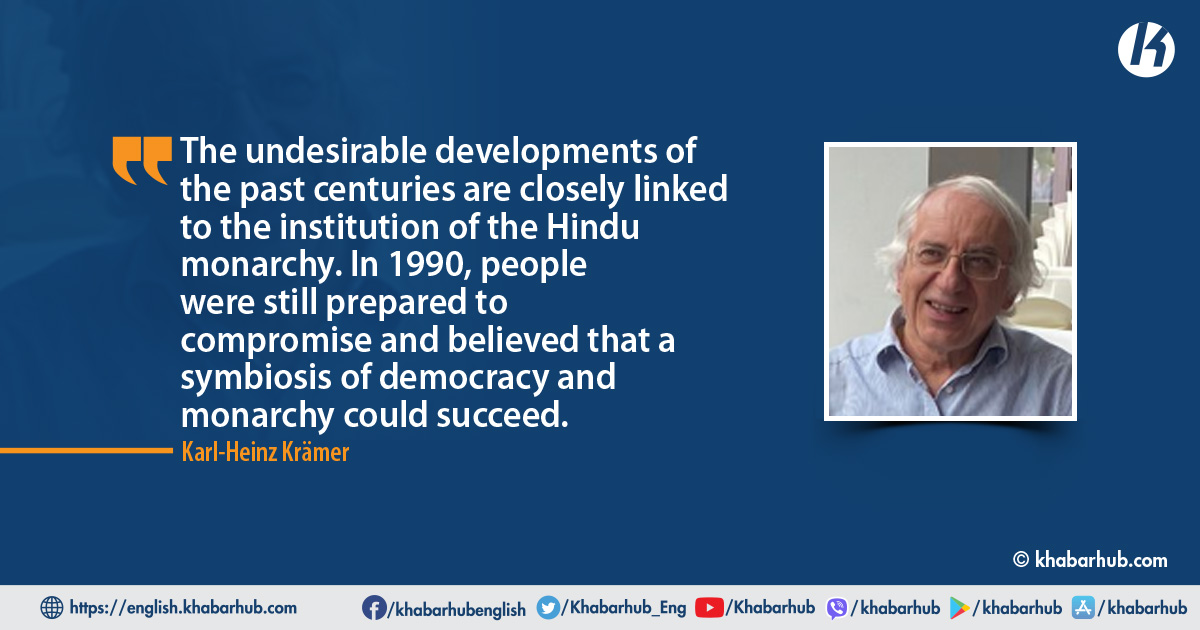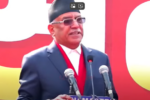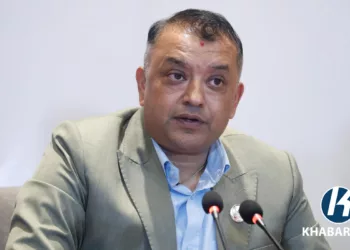Nepal is currently witnessing a wave of demonstrations and demands in support of a return to a Hindu state and monarchy.
What are the causes of this escalation, what are the chances of such a step and, above all, what would be the internal and international consequences?
Historical facts
Modern Nepal was created in the second half of the 18th century by the military conquests of the Shah monarchy of Gorkha.
Prithvi Narayan has since been celebrated by the ruling elite as the founder of the Nepalese unitary state.
It can be assumed that Nepal has only been able to maintain its independence to this day thanks to this larger territorial state.
On the other hand, the Shah monarchy and the circles that supported it organised the unitary state extremely on the basis of their own culture and values.
The history and culture of the numerous subjected population groups were purposefully suppressed. As early as the Muluki Ain of 1854, the imposed Hindu social hierarchy was deliberately used to categorise other population groups as subordinate and inferior to the ruling elite of the so-called higher Hindu castes.
Ethnic groups that, with the exception of the Newar, had no caste system at all were categorised as subordinate castes.
The 1990 constitution officially recognised the diversity of the country’s ethnicities, languages, cultures and religions for the first time.
In accordance with the patriarchal Hindu way of thinking, it was exclusively male members of the so-called high Hindu castes who henceforth saw themselves as the owners of the land.
This view was later intensified under King Mahendra, who attempted to turn Nepal into a culturally and ethnically unified state.
The languages, cultures and religions of the numerous ethnic groups were increasingly negated, as can be seen from the census data after 1961.
Their independent history no longer featured at all. The education system was used to convey this manipulated image to generations of young Nepalis as reality.
Power only changed hands within the ruling elite. Other groups have not really been involved to this day.
As this party entered the second assembly severely decimated, it quickly adapted to the now once again dominant major parties of the 1990s system. CPN (UML) and Nepali Congress had already rejected any ethnic reference in the first assembly.
Until the end of the absolutist monarchy in 1990, members of the Chhetri castes dominated, which may be related to the fact that the royal family was also part of this caste group.
With the increasing takeover of power by the political parties, the pendulum swung in favour of the Bahun castes.
This too was not surprising as the major parties have been extremely controlled by male Bahuns since their inception in exile in India in the late 1940s. The term “Bahunbad” was already used to describe this change in the early 1990s.
The 1990 constitution officially recognised the diversity of the country’s ethnicities, languages, cultures and religions for the first time.
However, this acknowledgement did not have an impact on better participation and a corresponding revision of the official Nepalese identity.
All public spheres of life remained a closed shop of male Khas Arya, now with the ever-increasing dominance of the Bahun.
It was only with Jana Andolan II that change seemed to be on the horizon, when the leaders of the political parties demonstrating on the streets publicly declared that they wanted to create a socially inclusive state based on a federal and secular republic.
The rest is known. Already during the first Constituent Assembly, the top politicians realised that they would jeopardise their own power in the long run if they continued to declare their support for a socially inclusive state.
The euphoria people felt in 2006 or 2008 has long since evaporated and given way to increasing frustration. The promises made by leading politicians at the time have largely proved to be a pack of lies.
After all, not even six per cent of Nepalis are male Bahun and not even 15 per cent are male Khas Arya.
In the second Constituent Assembly at the latest, every effort was therefore made to exclude any reference to the country’s ethnic and cultural diversity.
For example, the naming of the new provinces avoided any ethnic or ethnic-historical reference, which had been one of the main demands in the first assembly, even on the part of the then still strong Maoist party.
As this party entered the second assembly severely decimated, it quickly adapted to the now once again dominant major parties of the 1990s system. CPN (UML) and Nepali Congress had already rejected any ethnic reference in the first assembly.
The one-sided occupation of almost all offices and functions by male Khas Arya, especially Bahun, has not changed to this day.
The same applies to the upper echelons of the political parties. The much-heralded change under the new constitution is nowhere to be felt.
On the contrary, the negativisation of the PR system in elections has actually contributed to the male Khas Arya dominating even more than ever before, and furthermore abusing it through an almost unbearable degree of nepotism.
The proximity to corruption and crime is everywhere. The top politicians of all parties see themselves as irreplaceable, even though they have failed across the board and repeatedly violate the constitution and laws.
They mercilessly use an undemocratically structured party act to eliminate critics. They do not give the younger generation a chance to make their mark, even though this would be important for the future of the country.
They oppose the establishment and development of the federal system and try to keep everything under their control in a centralised manner.
It is said these days that the provinces have proved to be superfluous. This is primarily because the provinces have neither sufficient functions nor the necessary fiscal resources.
Even the composition of the provincial governments is determined by the party leaders of the central elite. If a government changes there, this must be immediately reflected in as many provinces as possible.
Nobody is interested in whether the provincial governments are functional at all, the main thing is that the party leaders in Kathmandu get their way.
Thus, the provinces do not serve the purpose of decentralisation but are merely additional posts for party politicians, which costs the state an enormous amount of money.
However, this mistake is not due to the intended system, but to its non-implementation by the top national politicians.
Growing dissatisfaction in society
The euphoria people felt in 2006 or 2008 has long since evaporated and given way to increasing frustration. The promises made by leading politicians at the time have largely proved to be a pack of lies.
Take the Maoist party alone, which today has nothing in common with its former revolutionary idea. Nowhere is it clearer what the voters think of this change.
This development is likely to be primarily due to protest voting behaviour, but the party has seen itself on the upswing since then and is constantly campaigning to achieve its goals.
In 2008, the party won half of all seats in the first Constituent Assembly. It also became the strongest force in the PR votes with around 30 per cent.
Since then, the party has fallen abysmally from election to election. In 2022, it only just became the third strongest party with 11 per cent, just ahead of the RSP, which had only recently been founded.
The fact that its party president nevertheless became prime minister once again demonstrates the undemocratic mindset and politics based purely on the desire for power of the top politicians.
But the other major parties are no better. In 2020/21, KP Oli tried to unhinge the parliamentary system twice against his better judgement.
The second dissolution of parliament was carried out with the help of the president on the basis of deliberate false statements and although the Supreme Court had denied him this authority.
Something like this is normally called a coup and should have had serious legal consequences. Not so in Nepal. Oli can continue to strive for power unchanged. Many more examples could be cited here.
The electoral alliances of 2022, particularly those of the ruling parties at the time, reduced the electoral system to absurdity.
It meant extensive manipulation of the elections, because in many cases voters had no opportunity to cast an independent vote at all.
Nevertheless, they managed to teach the political parties a lesson. As a result, all the major parties in the PR system crashed.
Despite the misguided electoral alliance, the ruling parties at the time were no longer able to secure their parliamentary majority.
The undesirable developments of the past centuries are closely linked to the institution of the Hindu monarchy. In 1990, people were still prepared to compromise and believed that a symbiosis of democracy and monarchy could succeed. Gyanendra’s coup, which was carried out in two stages, proved people wrong.
On the other hand, new parties that took part in the election for the first time made astonishing gains. This can be seen at least in part as protest voting behaviour.
This also included the RPP, which is unconstitutionally in favour of a return to the Hindu state and monarchy and the abolition of federalism and secularism. Compared to 2017, it improved from around two to 5.5 per cent of the PR vote.
This development is likely to be primarily due to protest voting behaviour, but the party has seen itself on the upswing since then and is constantly campaigning to achieve its goals.
In doing so, it seems to have missed the fact that it only received one in twenty votes and that there can be no question of broad support from the population.
Such campaigns are supported by people such as Durga Prasai or ex-king Gyanendra Shah, who seems to be clutching at straws.
The relatively low participation of the people in the latest such campaigns speaks for itself and confirms the assessment just made.
Dangers and opportunities of the demand for a return to the Hindu state and monarchy
First of all, it should be noted that support for such a demand from the mass of the population is extremely low. It probably exists primarily in the minds of Hindu fundamentalists and monarchists.
The majority of people clearly do not want to go back to these archaic, medieval ways of thinking and structures.
Nepal is rightly defined as a multi-ethnic, multi-religious, multicultural and multilingual state. This is only fitting for a secular and not a Hindu state.
Nepal is in many ways dependent on countries around the world that support it in its development endeavours and repeatedly help to improve the ailing economic situation.
The undesirable developments of the past centuries are closely linked to the institution of the Hindu monarchy. In 1990, people were still prepared to compromise and believed that a symbiosis of democracy and monarchy could succeed. Gyanendra’s coup, which was carried out in two stages, proved people wrong.
The year 2005 marked a turning point in people’s thinking. The vast majority of people no longer want to experience all the effects, disenfranchisement and oppression on the part of the Hindu state and monarchy.
A return to these institutions would be an anachronism at a time when support for monarchies is crumbling worldwide.
The proponents of Hindu state and monarchy should please tell us how they imagine the future of all those people who do not belong to the male Khas Arya elite, i.e. 85 per cent of the population.
What about, for example, the Janajati (35 per cent), a large proportion of whom are not Hindus, the Dalits (14 per cent), who have no chance at all in a Hindu state, the 51 per cent of women whose exclusion was part of the mindset of the Hindu monarchy and continues to this day?
Why else are women still not categorised as full Nepalis in citizenship law, but only men? If these abuses are finally to be remedied, there must be no return to the Hindu state and monarchy.
One question that is obviously not being asked at all in connection with the demonstrations by supporters of the Hindu state and monarchy is the image of Nepal abroad.
How fortunate that these fanatics are only a small minority. In order for them to remain so, it is necessary that the responsible politicians finally recognise and openly admit their numerous mistakes, withdraw from politics and hand over responsibility to a younger generation, which will hopefully avoid the mistakes of today’s party leaders.
Nepal is in many ways dependent on countries around the world that support it in its development endeavours and repeatedly help to improve the ailing economic situation.
Has anyone ever thought about the consequences of turning away from democratic values and structures and returning to the Hindu monarchy, which is responsible for many undesirable developments?
Many countries have been trying for years to help Nepal build democratic, federal structures and an inclusive and equal society.
All these efforts would have been completely in vain if Nepal now declared: We don’t want democracy at all; we would rather go back to the Shah monarchy, even if it has no personal future since the 2001 massacre and is no longer wanted at all by the majority of the population; we don’t want a state with which all the country’s inhabitants can identify, but once again a state that identifies itself exclusively with the male Khas Arya!
What a perversion! Do these fanatics really believe that the international community will swallow all this without a word, write off all the senseless expenditure made so far and pretend that nothing has happened?
Do they believe that the once again particularly marginalised population groups in Nepal would put up with all this without resistance? Or do they even want to start another civil war, this time with an ethnic-religious-cultural background?
How fortunate that these fanatics are only a small minority. In order for them to remain so, it is necessary that the responsible politicians finally recognise and openly admit their numerous mistakes, withdraw from politics and hand over responsibility to a younger generation, which will hopefully avoid the mistakes of today’s party leaders.
Nepal is not a Hindu monarchy, but a multi-ethnic, multi-religious, multi-cultural and multi-lingual democracy and the country should be proud of this.
(The views expressed in this article are those of the author and do not necessarily reflect the official policy or position of Khabarhub)









Comment